Keeping stainless steel appliances clean and shiny can be a challenge, but with the right approach, you can maintain their sleek appearance effortlessly.
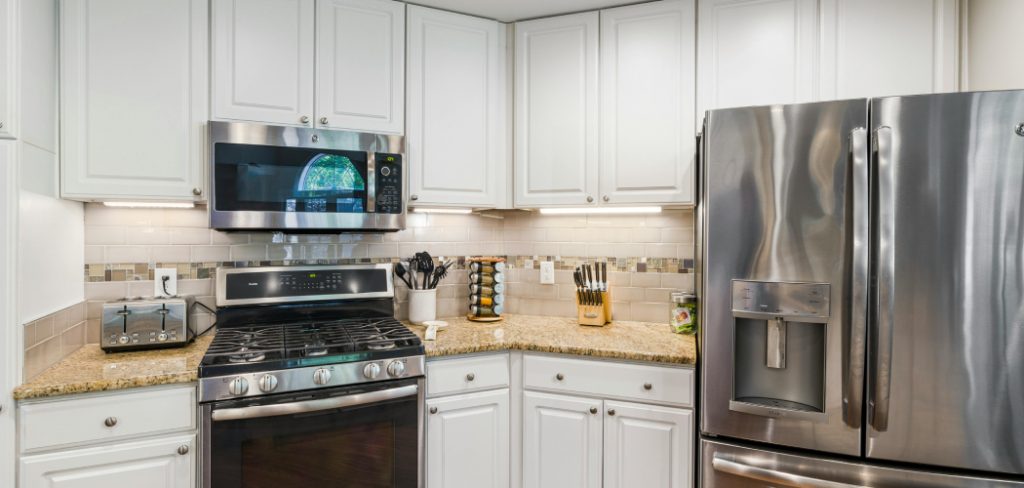
These appliances are not only durable but also add a modern touch to any kitchen. However, fingerprints, smudges, and stains can quickly diminish their appeal.
This guide on how to clean stainless steel appliances will walk you through simple, effective methods to clean and care for your stainless steel appliances, helping them look their best for years to come.
Why Stainless Steel Appliances Need Special Care?
Stainless steel is a popular material for kitchen appliances due to its durability, resistance to rust and corrosion, and sleek appearance.
However, this material is prone to showing fingerprints, water spots, and other marks easily.
Additionally, using the wrong cleaning products or techniques can damage the surface of stainless steel appliances permanently.
Therefore, it’s essential to have a specific cleaning routine for your stainless steel appliances to keep them looking new and in top condition.
Tools You Will Need
Before you begin cleaning your stainless steel appliances, gather all the necessary tools. These include:
- Soft Microfiber Cloths or Towels
- Water
- Mild Dish Soap or Stainless Steel Cleaner
- White Vinegar
- Olive Oil or Mineral Oil (Optional)
10 Step-by-step Guides on How to Clean Stainless Steel Appliances
Step 1: Prepare the Surface
Begin by removing any loose debris or dust from the surface of your stainless steel appliance. Use a dry microfiber cloth to gently wipe away crumbs, dirt, or other particles that may scratch the surface during cleaning. Inspect the appliance closely to identify problem areas, such as fingerprints or smudges, so you can focus your effort on those spots during the cleaning process.
Taking the time to properly prepare the surface ensures a smoother and more effective cleaning experience.
Step 2: Use Water
For everyday cleaning, water is often all you need to clean your stainless steel appliances. Using a damp microfiber cloth or towel, wipe the surface gently in the direction of the grain. Avoid using tap water as it may leave mineral deposits on your appliances. Instead, use distilled or filtered water for best results.
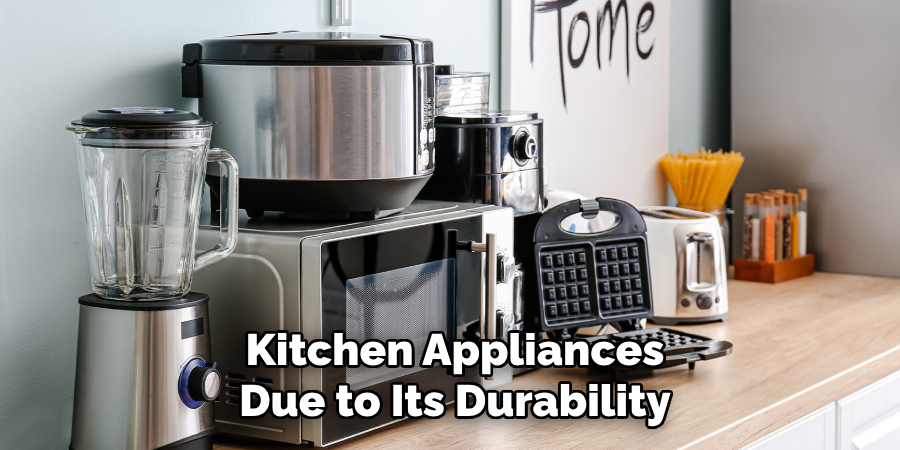
You can also add a few drops of dish soap to the water for tougher stains or build-up. Make sure to rinse the surface thoroughly with clean water and dry it with a soft cloth.
Step 3: Try Vinegar
Vinegar is an excellent natural cleaner that effectively removes stubborn stains and grime from stainless steel appliances. Mix equal parts of white vinegar and water in a spray bottle, and then spray the solution onto the surface. Allow it to sit for a few minutes before wiping it off with a damp microfiber cloth. Finally, rinse the surface with clean water and dry it thoroughly.
Note: Avoid using apple cider or balsamic vinegar as they may stain your appliance.
Step 4: Use a Stainless Steel Cleaner
If your stainless steel appliance has tough stains or build-up, you may need to use a specialized stainless steel cleaner. Choose a cleaner that is specifically designed for stainless steel and follow the instructions on the label carefully. Typically, you will need to apply the cleaner onto a cloth and wipe it onto the surface, then rinse with clean water and dry with a soft cloth.
The key is to use a minimal amount of cleaner and avoid harsh chemicals that can damage the surface.
Step 5: Remove Stubborn Stains
For stubborn stains or built-up grime, you may need to apply more pressure or use a gentle scrubbing brush. Always make sure to test the brush on an inconspicuous area first to ensure it doesn’t cause any scratches. Use circular motions and be gentle when scrubbing to avoid damaging the surface.
If the stain still won’t come off, try making a paste with baking soda and water. Apply it onto the stain, let it sit for a few minutes, then gently scrub and rinse off with clean water.
Step 6: Pay Attention to the Grain
Stainless steel appliances have a grain or brushed finish, which can be seen in the direction of the lines on the surface. When cleaning, always wipe in the direction of this grain to avoid leaving scratches or streaks.
It’s also essential to use a clean cloth or change sides frequently when cleaning to avoid spreading any dirt or grime around.
Step 7: Dry Thoroughly
After cleaning, always make sure to dry the surface thoroughly with a soft microfiber cloth. Water spots or streaks can form if you leave the surface wet, which can be difficult to remove. Additionally, moisture left on the surface can lead to rust or corrosion over time.
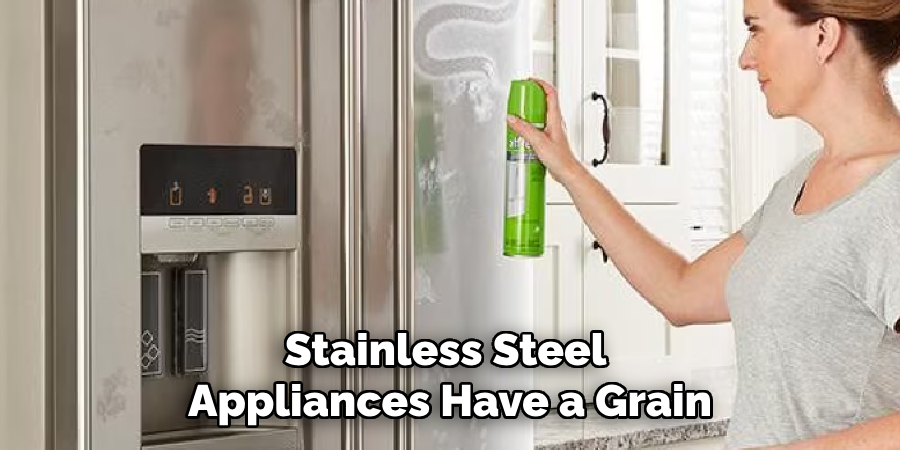
You can also use a few drops of olive or mineral oil on a clean cloth to buff the surface and add shine, but this step is optional.
Step 8: Clean the Handles
Don’t forget to clean the handles and knobs on your stainless steel appliances. These areas are often touched frequently and can quickly become dirty. Use the same cleaning method you did for the rest of the appliances, and dry them thoroughly.
It’s also a good idea to disinfect these areas regularly, especially in times of illness or when handling raw meat.
Step 9: Maintain Regularly
To keep your stainless steel appliances looking their best, it’s essential to maintain them regularly. Wipe down the surfaces with water or mild dish soap after each use, especially if there are any spills or stains. This will prevent build-up and make it easier to clean in the long run.
Additionally, avoid using abrasive materials or harsh chemicals on your appliances as they can damage the surface. Stick to gentle cleaning methods and products specifically designed for stainless steel.
Step 10: Protect from Scratches
Prevent scratches on your stainless steel appliances by using cutting boards or trivets when placing hot pots or pans on them. Avoid using metal scouring pads or sharp objects that can leave deep scratches on the surface.
If you do end up with a scratch, you can use a commercial stainless steel scratch remover, but be sure to follow the instructions on how to clean stainless steel appliances carefully.
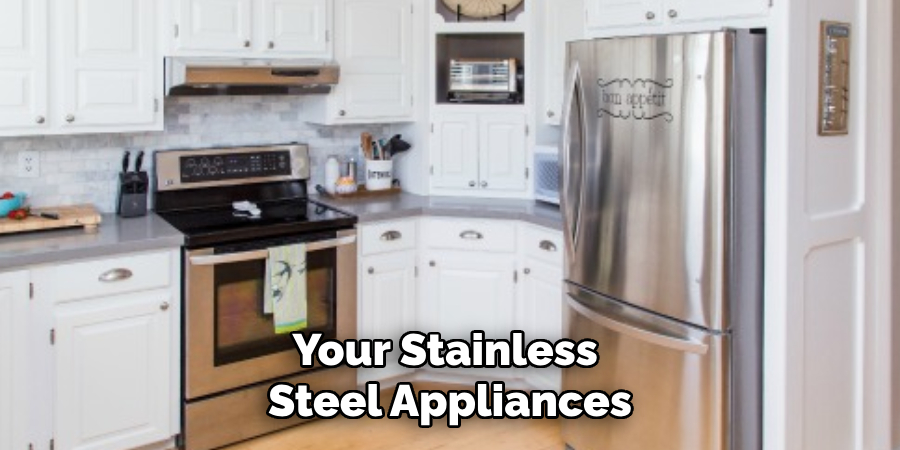
Additional Tips
- Regularly dust your stainless steel appliances to prevent build-up.
- Use microfiber cloths or towels specifically designed for cleaning stainless steel to avoid scratching the surface.
- Avoid using harsh chemicals on your appliances as they can cause damage and discoloration.
- When in doubt, always test a small area first before applying any new cleaning methods or products onto the entire surface.
- Wipe up spills or stains as soon as possible to prevent them from drying and becoming more difficult to remove. Most importantly, remember to take your time when cleaning stainless steel appliances. Rushing through the process can result in scratches or streaks, so be patient and thorough for the best results. With these steps and tips, you can keep your stainless steel appliances looking shiny and new for years to come. Happy cleaning!
Frequently Asked Questions
Q: Can I Use Bleach to Clean Stainless Steel Appliances?
A: No, bleach is too harsh and can damage the surface of your stainless steel appliance. It’s best to stick to gentler cleaning methods. It is also not recommended to use abrasive materials and harsh chemicals on stainless steel appliances as they can cause damage.
Q: How Often Should I Clean My Stainless Steel Appliances?
A: It’s a good idea to clean your appliances regularly, at least once a week or after each use. This will prevent build-up and make it easier to maintain over time.
Q: Can I Use Steel Wool to Clean Stubborn Stains?
A: No, steel wool is too abrasive and can leave scratches on the surface of your stainless steel appliance. It’s best to use gentler cleaning methods and avoid harsh materials like steel wool.
Q: How Do I Remove Fingerprints from My Stainless Steel Appliances?
A: To remove fingerprints from your appliances, you can use a microfiber cloth dampened with water or vinegar. Wipe in the direction of the grain for best results. You can also use a specialized stainless steel cleaner for tougher stains, but be sure to test it on an inconspicuous area first. Regular maintenance and cleaning can also help prevent fingerprints from showing up in the first place.
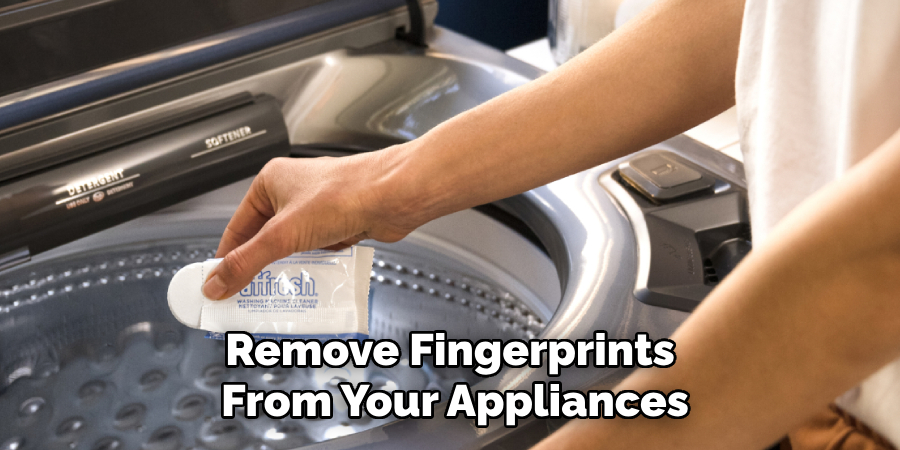
Conclusion
Properly cleaning and maintaining your stainless steel appliances not only keeps them looking shiny and new but also extends their lifespan. By following these step-by-step guides on how to clean stainless steel appliances, you can easily tackle stains, smudges, and grime while preventing long-term damage such as scratches or corrosion.
Essential tools like microfiber cloths, vinegar, and mild cleaners make the process both effective and environmentally friendly. Regular upkeep and gentle cleaning methods are key to preserving the polished finish of your appliances, ensuring they stay a focal point in your home for years to come.
Edmund Sumlin is a skilled author for Metal Fixes, bringing 6 years of expertise in crafting a wide range of metal fixtures. With a strong background in metalwork, Edmund’s knowledge spans various types of fixtures, from decorative pieces to functional hardware, blending precision with creativity. His passion for metalworking and design has made him a trusted resource in the industry.
Professional Focus:
- Expert in Metal Fixtures : Edmund aesthetic specializes in creating durable and innovative metal fixtures, offering both appeal and functionality. His work reflects a deep understanding of metalworking techniques and materials.
- Sustainability Advocate : He is dedicated to using sustainable practices, ensuring that every fixture is crafted with eco-friendly methods while maintaining high-quality standards.
In his writing for Metal Fixes, Edmund provides valuable insights into the latest trends, techniques, and practical advice for those passionate about metal fixtures, whether they are professionals or DIY enthusiasts. His focus on combining artistry with engineering helps others discover the true potential of metal in design.


